| Listing 1 - 10 of 21 | << page >> |
Sort by
|
Periodical
ISSN: 02777363 Year: 1959 Publisher: [Provo, Utah] : [Brigham Young University],
Abstract | Keywords | Export | Availability | Bookmark
 Loading...
Loading...Choose an application
- Reference Manager
- EndNote
- RefWorks (Direct export to RefWorks)
Mormons --- Mormons. --- Mormoni --- Latter-Day Saints --- Christians --- Latter Day Saints --- Brighamite Mormons --- Church of Christ (Temple Lot) members --- Church of Jesus Christ of Latter-day Saints members --- Church of Jesus Christ (Strangites) members --- Hedrikites --- Josephite Mormons --- Reorganized Church of Jesus Christ of Latter Day Saints members --- Reorganized Mormons --- RLDS Mormons --- Strangite Mormons --- Temple Lot Mormons --- Utah Mormons --- Latter Day Saints.
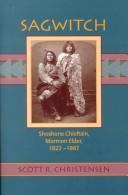
ISBN: 0874212707 0874213592 0585207623 Year: 1999 Publisher: Logan, Utah : Utah State University, University Libraries,
Abstract | Keywords | Export | Availability | Bookmark
 Loading...
Loading...Choose an application
- Reference Manager
- EndNote
- RefWorks (Direct export to RefWorks)
The Northwestern Shoshone knew as home the northern Great Salt Lake, Bear River, Cache, and Bear Lake valleys-northern Utah. Sagwitch was born at a time when his people traded with the mountain men. In the late 1850s, wagons brought Mormon farmers to settle in Cache Valley, the Northwestern Shoshone heartland. Emigrants and settlers reduced Shoshone access to traditional village sites and food resources. Relationships with the Mormons were mostly good but often strained, and the Shoshone treatment of migrants, who now traveled north and south as well as west and east through the area, was increasingly opportunistic. It only took a few violent incidents for a zealous army colonel to seek severe punishment of the Northwestern Shoshone on a winter morning in 1863. The Bear River Massacre was among the bloodiest engagements of America's Indian wars. Hundreds of Shoshone, including Sagwitch's wife and two sons, died; he was wounded but escaped. The band was shattered; other chiefs dead.The following years were very hard for the survivors. The federal government negotiated a treaty with them but failed to get Sagwitch's signature when, enroute to the sessions, he was arrested and then wounded by a white assassin. With the world around him changed, Sagwitch sought accommodation with the most immediate threat to his people's traditional way of survival-the Mormons occupying the Shoshone's valleys.This, then, is also the story of the conversion of Sagwitch and his band to the Mormon Church. Though not without problems, that conversion was long lasting and thorough. Sagwitch and other Shoshone would demonstrate in important ways their new religious devotion. With the assistance of Mormon leaders, they established the Washakie community in northern Utah. Though efforts to secure a land base had an uneven history, they partly succeeded, and the story of these Shoshone's attempts at rural farming diverged significantly from what happened on government reservations. When Sagwitch died, his death went almost unnoticed outside of Washakie, but his children and grandchildren continued to be important voices among a people who, after experiencing near annihilation, survived in the new world into which Sagwitch led them.
Shoshoni Indians --- Mormons --- History --- Sagwitch, --- Shoshone Indians --- Snake Indians --- Indians of North America --- Numic Indians --- Shoshonean Indians --- Latter Day Saints --- Brighamite Mormons --- Church of Christ (Temple Lot) members --- Church of Jesus Christ of Latter-day Saints members --- Church of Jesus Christ (Strangites) members --- Hedrikites --- Josephite Mormons --- Reorganized Church of Jesus Christ of Latter Day Saints members --- Reorganized Mormons --- RLDS Mormons --- Strangite Mormons --- Temple Lot Mormons --- Utah Mormons --- Christians
Book
ISBN: 0874217229 9786612822230 0874217237 1282822233 9780874217230 9780874217223 9781282822238 Year: 2008 Publisher: Utah State University, University Libraries
Abstract | Keywords | Export | Availability | Bookmark
 Loading...
Loading...Choose an application
- Reference Manager
- EndNote
- RefWorks (Direct export to RefWorks)
Winner of the Evans Handcart Prize 2009. Winner of the Mormon History Assn Best Biography Award 2009. By the early twentieth century, the era of organized Mormon colonization of the West from a base in Salt Lake City was all but over. One significant region of Utah had not been colonized because it remained in Native American hands--the Uinta Basin, site of a reservation for the Northern Utes. When the federal government decided to open the reservation to white settlement, William H. Smart--a nineteenth-century Mormon traditionalist living in the twentieth century, a polygamist in an era when it was banned, a fervently moral stake president who as a youth had struggled mightily with his own sense of sinfulness, and an entrepreneurial businessman with theocratic, communal instincts--set out to ensure that the Uinta Basin also would be part of the Mormon kingdom. Included with the biography is a searchable CD containing William H. Smart's extensive journals, a monumental personal record of Mormondom and its transitional period from nineteenth-century cultural isolation into twentieth-century national integration.
Mormons -- Utah -- Biography. --- Smart, William H. (William Henry), 1862-1937. --- Utah -- History. --- Mormons --- Religion --- Philosophy & Religion --- Christianity --- Smart, William H. --- Utah --- History. --- Latter Day Saints --- Brighamite Mormons --- Church of Christ (Temple Lot) members --- Church of Jesus Christ of Latter-day Saints members --- Church of Jesus Christ (Strangites) members --- Hedrikites --- Josephite Mormons --- Reorganized Church of Jesus Christ of Latter Day Saints members --- Reorganized Mormons --- RLDS Mormons --- Strangite Mormons --- Temple Lot Mormons --- Utah Mormons --- Christians
Periodical
ISSN: 15549399 00122157 Year: 1966 Publisher: Salt Lake City, UT : Dialogue Foundation,
Abstract | Keywords | Export | Availability | Bookmark
 Loading...
Loading...Choose an application
- Reference Manager
- EndNote
- RefWorks (Direct export to RefWorks)
"A journal of Mormon thought."
Mormon Church --- Mormons --- Mormon Church. --- Mormons. --- Latter-Day Saints --- Mormonism --- Christian sects --- Arts and Humanities --- Religion --- Christians --- Latter Day Saints --- Latter Day Saint churches --- Brighamite Mormons --- Church of Christ (Temple Lot) members --- Church of Jesus Christ of Latter-day Saints members --- Church of Jesus Christ (Strangites) members --- Hedrikites --- Josephite Mormons --- Reorganized Church of Jesus Christ of Latter Day Saints members --- Reorganized Mormons --- RLDS Mormons --- Strangite Mormons --- Temple Lot Mormons --- Utah Mormons
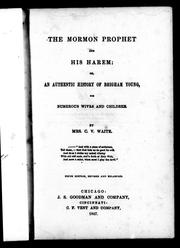
ISBN: 066537321X Year: 1867 Publisher: Chicago : Cincinnati : J.S. Goodman; C.F. Vent,
Abstract | Keywords | Export | Availability | Bookmark
 Loading...
Loading...Choose an application
- Reference Manager
- EndNote
- RefWorks (Direct export to RefWorks)
Mormon Church --- Mormons --- History. --- Histoire. --- Young, Brigham, --- Église mormone --- Mormonism --- Christian sects --- Brighamite Mormons --- Church of Christ (Temple Lot) members --- Church of Jesus Christ of Latter-day Saints members --- Church of Jesus Christ (Strangites) members --- Hedrikites --- Josephite Mormons --- Reorganized Church of Jesus Christ of Latter Day Saints members --- Reorganized Mormons --- RLDS Mormons --- Strangite Mormons --- Temple Lot Mormons --- Utah Mormons --- Christians --- Latter Day Saint churches --- Latter Day Saints
Periodical
ISSN: 15180594 Year: 1999 Publisher: Provo, UT : Association for Mormon Letters
Abstract | Keywords | Export | Availability | Bookmark
 Loading...
Loading...Choose an application
- Reference Manager
- EndNote
- RefWorks (Direct export to RefWorks)
Arts and Humanities --- Literature --- American literature --- Mormons --- American literature. --- Mormons. --- Mormon authors --- 1900-1999 --- Latter-Day Saints --- Christians --- Agrarians (Group of writers) --- English literature --- Latter Day Saints --- Latter Day Saint authors --- Brighamite Mormons --- Church of Christ (Temple Lot) members --- Church of Jesus Christ of Latter-day Saints members --- Church of Jesus Christ (Strangites) members --- Hedrikites --- Josephite Mormons --- Reorganized Church of Jesus Christ of Latter Day Saints members --- Reorganized Mormons --- RLDS Mormons --- Strangite Mormons --- Temple Lot Mormons --- Utah Mormons
Book
ISBN: 9780810858145 0810858142 9780810862517 0810862514 Year: 2008 Volume: 89 Publisher: Lanham Toronto Plymouth Scarecrow Press
Abstract | Keywords | Export | Availability | Bookmark
 Loading...
Loading...Choose an application
- Reference Manager
- EndNote
- RefWorks (Direct export to RefWorks)
Clears up many of the misconceptions held about Mormonism and its members, making it an essential reference.
Mormon Church --- -Mormons --- -289.3 --- Latter-Day Saints --- Mormonism --- Christian sects --- Mormons --- Mormonen. Church of Jesus Christ of Latter Day Saints --- 289.3 Mormonen. Church of Jesus Christ of Latter Day Saints --- 289.3 --- Christians --- Latter Day Saints --- Brighamite Mormons --- Church of Christ (Temple Lot) members --- Church of Jesus Christ of Latter-day Saints members --- Church of Jesus Christ (Strangites) members --- Hedrikites --- Josephite Mormons --- Reorganized Church of Jesus Christ of Latter Day Saints members --- Reorganized Mormons --- RLDS Mormons --- Strangite Mormons --- Temple Lot Mormons --- Utah Mormons
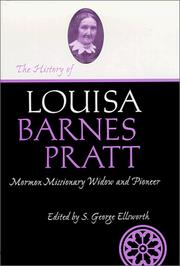
ISBN: 0874216435 0874212529 0874213053 0585033668 9780874213058 9780585033662 9780874212525 9780874216431 Year: 1998 Publisher: Logan, Utah : Utah State University Press,
Abstract | Keywords | Export | Availability | Bookmark
 Loading...
Loading...Choose an application
- Reference Manager
- EndNote
- RefWorks (Direct export to RefWorks)
Volume 3, Life Writings of Frontier Women series, ed. Maureen Ursenbach BeecherIn her memoir, and 1870's revision of her journal and diary, Louisa Barnes Pratt tells of childhood in Massachusetts and Canada during the War of 1812, and independent career as a teacher and seamstress in New England, and her marriage to the Boston seaman Addison Pratt.Converting to the LDS Church, the Pratts moved to Nauvoo, Illinois, from where Brigham Young sent Addison on the first of the long missions to the Society Islands that would leave Louisa on her own. As a sole available parent,
Frontier and pioneer life. --- Mormons - United States - Biography. --- Mormons -- United States -- Biography. --- Pratt, Louisa Barnes. --- Pratt, Louisa Barnes, 1802-1880. --- Mormons --- Frontier and pioneer life --- Religion --- Philosophy & Religion --- Christianity --- Biography --- Pratt, Louisa Barnes, --- Border life --- Homesteading --- Pioneer life --- History --- Barnes, Louisa, --- Adventure and adventurers --- Manners and customs --- Pioneers --- Latter Day Saints --- Brighamite Mormons --- Church of Christ (Temple Lot) members --- Church of Jesus Christ of Latter-day Saints members --- Church of Jesus Christ (Strangites) members --- Hedrikites --- Josephite Mormons --- Reorganized Church of Jesus Christ of Latter Day Saints members --- Reorganized Mormons --- RLDS Mormons --- Strangite Mormons --- Temple Lot Mormons --- Utah Mormons --- Christians
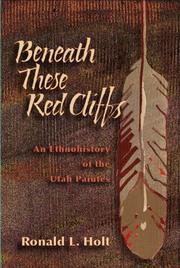
ISBN: 0874216370 9786613078025 0874215420 1283078023 9780874215427 9781283078023 9780874216370 Year: 2006 Publisher: Utah State University, University Libraries
Abstract | Keywords | Export | Availability | Bookmark
 Loading...
Loading...Choose an application
- Reference Manager
- EndNote
- RefWorks (Direct export to RefWorks)
Ronald Holt recounts the survival of a people against all odds. A compound of rapid white settlement of the most productive Southern Paiute homelands, especially their farmlands near tributaries of the Colorado River; conversion by and labor for the Mormon settlers; and government neglect placed the Utah Paiutes in a state of dependency that ironically culminated in the 1957 termination of their status as federally recognized Indians. That recognition and attendant services were not restored until 1980, in an act that revived the Paiutes' identity, self-government, land ownership, and sense of
Mormons -- History -- Sources. --- Mormons -- Social conditions. --- Paiute Indians -- Government relations. --- Paiute Indians -- History -- Sources. --- Paiute Indians -- Social conditions. --- Paiute Indians --- Mormons --- Gender & Ethnic Studies --- Social Sciences --- Ethnic & Race Studies --- History --- Government relations --- Social conditions --- Government relations. --- Social conditions. --- Latter-Day Saints --- Pah-Ute Indians --- Piute Indians --- Mormon Church --- Indians of North America --- Numic Indians --- Christians --- Latter Day Saints --- Brighamite Mormons --- Church of Christ (Temple Lot) members --- Church of Jesus Christ of Latter-day Saints members --- Church of Jesus Christ (Strangites) members --- Hedrikites --- Josephite Mormons --- Reorganized Church of Jesus Christ of Latter Day Saints members --- Reorganized Mormons --- RLDS Mormons --- Strangite Mormons --- Temple Lot Mormons --- Utah Mormons
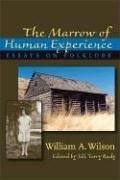
ISBN: 0874216532 9786613267368 1283267365 0874215455 9780874215458 9780874216530 Year: 2006 Publisher: Utah State University, University Libraries
Abstract | Keywords | Export | Availability | Bookmark
 Loading...
Loading...Choose an application
- Reference Manager
- EndNote
- RefWorks (Direct export to RefWorks)
Composed over several decades, the essays here are remarkably fresh and relevant. They offer instruction for the student just beginning the study of folklore as well as repeated value for the many established scholars who continue to wrestle with issues that Wilson has addressed. As his work has long offered insight on critical mattersn--nationalism, genre, belief, the relationship of folklore to other disciplines in the humanities and arts, the currency of legend, the significance of humor as a cultural expression, and so forth--so his recent writing, in its reflexive approach to narrative and storytelling, illuminates today's paradigms. Its notable autobiographical dimension, long an element of Wilson's work, employs family and local lore to draw conclusions of more universal significance. Another way to think of it is that newer folklorists are catching up with Wilson and what he has been about for some time.As a body, Wilson's essays develop related topics and connected themes. This collection organizes them in three coherent parts. The first examines the importance of folklore. What it is and its value in various contexts. Part two, drawing especially on the experience of Finland, considers the role of folklore in national identity, including both how it helps define and sustain identity and the less savory ways it may be used for the sake of nationalistic ideology. Part three, based in large part on Wilson's extensive work in Mormon folklore, which is the most important in that area since that of Austin and Alta Fife, looks at religious cultural expressions and outsider perceptions of them and, again, at how identity is shaped, by religious belief, experience, and participation; by the stories about them; and by the many other expressive parts of life encountered daily in a culture. Each essay is introduced by a well-known folklorist who discusses the influence of Wilson's scholarship. These include Richard Bauman, Margaret Brady, Simon Bronner, Elliott Oring, Henry Glassie, David Hufford, Michael Owen Jones, and Beverly Stoeltje.In these essays William Wilson illuminates folklore theory and practice, romantic nationalism, religious folklore, personal narrative, and much else. Each essay is introduced by a notable fellow folklorist, among them Richard Bauman, Margaret K. Brady, Simon J. Bronner, Henry Glassie, David J. Hufford, Michael Owen Jones, Elliott Oring, Steve Siporin, David Stanley, Beverly Stoeltje, and Jacqueline S. Thursby.
Folklore and nationalism. --- National characteristics. --- Folklore --- Mormons --- Latter-Day Saints --- Characteristics, National --- Identity, National --- Images, National --- National identity --- National images --- National psychology --- Psychology, National --- Folk-lore and nationalism --- Nationalism and folklore --- Folklore. --- Mormon Church --- Anthropology --- Nationalism --- Social psychology --- Collective memory --- Ethnopsychology --- Exceptionalism --- Christians --- Latter Day Saints --- Brighamite Mormons --- Church of Christ (Temple Lot) members --- Church of Jesus Christ of Latter-day Saints members --- Church of Jesus Christ (Strangites) members --- Hedrikites --- Josephite Mormons --- Reorganized Church of Jesus Christ of Latter Day Saints members --- Reorganized Mormons --- RLDS Mormons --- Strangite Mormons --- Temple Lot Mormons --- Utah Mormons
| Listing 1 - 10 of 21 | << page >> |
Sort by
|

 Search
Search Feedback
Feedback About
About Help
Help News
News